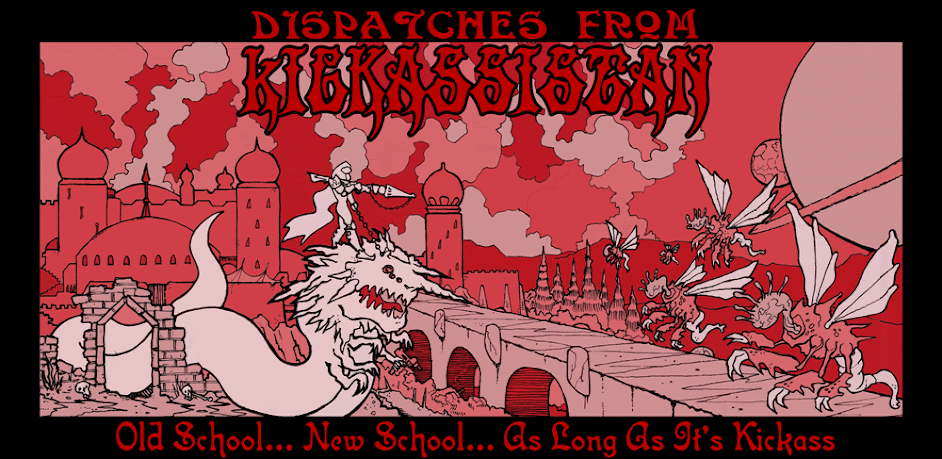Welcome back to Day Two of Delving Deeper week. Like yesterday's post, today's comes in the form of a question I posed to Delving Deeper designer +Simon Bull via email and his (slightly reformatted) answer to said question. Today, the question I asked was nearly a case of biting off more than I could chew. One of the things that had initially sparked my interest in DD was the simple yet sophisticated attack progression. Little did I expect the depths of Simon's madness dogged pursuit of nailing this thing down so firmly, there was no chance of it ever getting away.
Recently, on his blog Save Vs. All Wands, Seven Voyages of Zylarthen author +Oakes Spalding did a comparison of attack tables from OD&D and various retro-clones. In his second post on the topic, he says that "the author of Delving Deeper has a complex but logical, fascinating and satisfying rationale for why the Delving Deeper progressions are in a certain sense faithful (perhaps even more faithful than the original numbers) to the mathematical theory behind the 0e progressions, based partly on what they owe to Chainmail." (Find that post here.) Would you mind walking me through that rationale?
Recently, on his blog Save Vs. All Wands, Seven Voyages of Zylarthen author +Oakes Spalding did a comparison of attack tables from OD&D and various retro-clones. In his second post on the topic, he says that "the author of Delving Deeper has a complex but logical, fascinating and satisfying rationale for why the Delving Deeper progressions are in a certain sense faithful (perhaps even more faithful than the original numbers) to the mathematical theory behind the 0e progressions, based partly on what they owe to Chainmail." (Find that post here.) Would you mind walking me through that rationale?
The first thing is that DD takes pains to be legal so doesn't copy the original attack matrices verbatim. It presents an alternate attack matrix that is similar to the original, but different enough to be its own thing.
How did I arrive at it? I began by looking at how the original attack matrices "work" in terms of fighting capability, numbers of hit dice, and numbers of experience points (for player levels 1-12).
From these charts we see right away that there are essentially three attack "tiers" represented (for player levels 1-12), with fighters alone achieving a fourth tier at top levels.
Looking at the Fighting Capability chart (which shows only the minimum FC necessary to enter each tier) we observe that:
. The first tier equates to fighting capabilities in the "man" range,
. The second tier equates to fighting capabilities in the "hero" range,
. The third tier (and forth tier, for fighters) equates to fighting capabilities in the "superhero" (or "wizard") range.
With this in mind, we can look at the Hit Dice Chart (which shows only the minimum HD necessary to enter each tier) and observe that: Players require 3-4 HD to obtain the second (heroic) tier, Players require 7-8 HD to obtain the third (superheroic) tier--excepting EGG's original thief which breaks the pattern by requiring only 5 HD.
The XP Chart then shows us how soon each class can expect to obtain the second and third attack tiers, and that fighters are clearly out in front of the other classes.
We also see here that the progression of EGG's original thief is, probably, disjointed from the original classes insofar as they are supposed to attack as do clerics, but their smaller XP requirement actually puts them way ahead of clerics in real terms, and only marginally behind fighters! This for a class EGG describes as being
"not meant to fight".
From all this I extrapolated several "facts" upon which I based the DD progressions:
1. The three attack tiers represent the Normal, Heroic, and Superheroic attack tiers,
2. The heroic attack tier begins at 3 HD,
3. The superheroic attack tier begins at 7 HD.
Additionally, I concluded that EGG's original thief's HD progression bucks the trend as it doesn't neatly fit the pattern observed for the original three classes. (This is why the DD thief's HD progression appears to be completely fabricated; it is. It is fabricated so as to align with the pattern of progression observed in the original three classes.)
So now we come to the DD attack matrices.
We can observe that:
. All players require minimum 3 HD to obtain the heroic attack tier,
. All players require minimum 7 HD to obtain the superheroic attack tier,
. Thieves follow the same pattern as the original three classes,
. Thieves now advance in attack capability slightly behind clerics (a better fit--in my mind--for a class which is "not meant to fight").
DD also provides a finer grained attack matrix for those who prefer it.This is the kind of hard work and dedication to "getting it right" that really rocks my gaming world. Long time Dispatches readers will remember how I've obsessed over dice math, so it really shouldn't be a surprise that I dug the thoroughness here. Rules that do precisely what the designer wants them to do and create exactly the game experience the designer wanted them to are rarities in today's gaming industry (if was ever not rare). Sure, games don't have to be about what they have rules for, but it's pretty damned cool if, when the rules are implemented, they have the impact that the designer intended them to have.
This simply divides each of the coarse attack tiers into finer parts, ensuring--as possible--that fighters advance ahead of clerics, who advance ahead of thieves, who advance ahead of magic-users.

